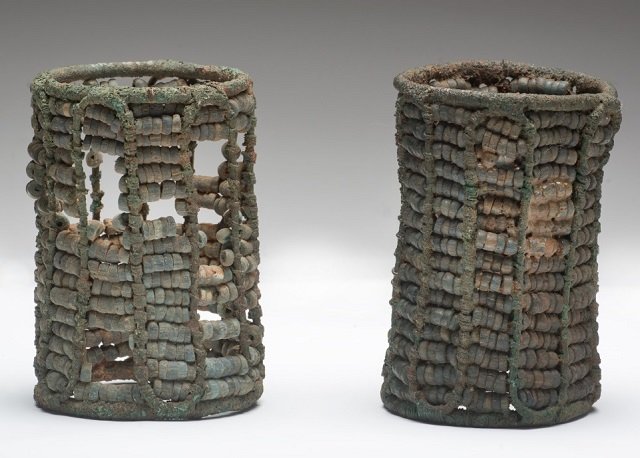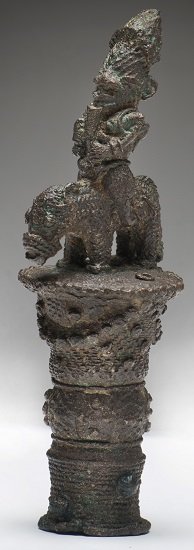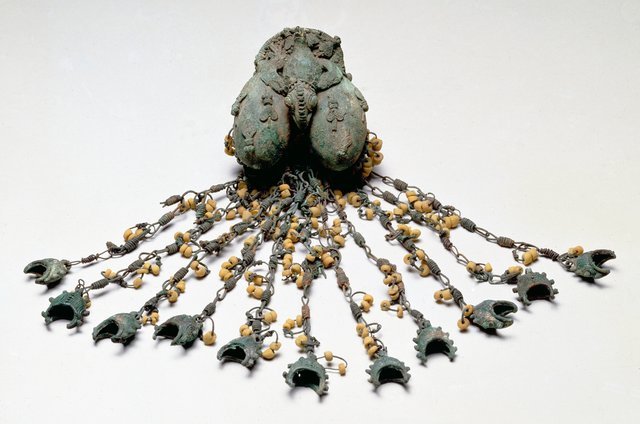![Armlets]() Armlets, 9th/10th century, excavated at Igbo Richard, Igbo Ukwu, eastern Nigeria. Beads and copper wire, height 14.9 cm. National Commission for Museums and Monuments, Abuja, Nigeria, IR.416 and IR.417. Photograph by Uche James Iroha
Armlets, 9th/10th century, excavated at Igbo Richard, Igbo Ukwu, eastern Nigeria. Beads and copper wire, height 14.9 cm. National Commission for Museums and Monuments, Abuja, Nigeria, IR.416 and IR.417. Photograph by Uche James Iroha
![Horse and rider finial]() Horse and rider finial, Igbo Ukwu, excavated from Igbo Richard (burial), 8th/early 11th century. Bronze, 14 x 5 cm. National Commission for Museums and Monuments, Abuja, Nigeria, IR.350. Photograph by Uche James Iroha
Horse and rider finial, Igbo Ukwu, excavated from Igbo Richard (burial), 8th/early 11th century. Bronze, 14 x 5 cm. National Commission for Museums and Monuments, Abuja, Nigeria, IR.350. Photograph by Uche James Iroha
![Double-egg pendant]() Double-egg pendant, 9th/10th century, excavated at Igbo Richard, Igbo Ukwu, eastern Nigeria. Leaded bronze, glass beads, 1 x 6 x 5.5 in. National Commission for Museums and Monuments, Abuja, Nigeria, IS.367. Photograph © Dirk Bakker/Bridgeman Images
Double-egg pendant, 9th/10th century, excavated at Igbo Richard, Igbo Ukwu, eastern Nigeria. Leaded bronze, glass beads, 1 x 6 x 5.5 in. National Commission for Museums and Monuments, Abuja, Nigeria, IS.367. Photograph © Dirk Bakker/Bridgeman Images
 Armlets, 9th/10th century, excavated at Igbo Richard, Igbo Ukwu, eastern Nigeria. Beads and copper wire, height 14.9 cm. National Commission for Museums and Monuments, Abuja, Nigeria, IR.416 and IR.417. Photograph by Uche James Iroha
Armlets, 9th/10th century, excavated at Igbo Richard, Igbo Ukwu, eastern Nigeria. Beads and copper wire, height 14.9 cm. National Commission for Museums and Monuments, Abuja, Nigeria, IR.416 and IR.417. Photograph by Uche James Iroha
 Horse and rider finial, Igbo Ukwu, excavated from Igbo Richard (burial), 8th/early 11th century. Bronze, 14 x 5 cm. National Commission for Museums and Monuments, Abuja, Nigeria, IR.350. Photograph by Uche James Iroha
Horse and rider finial, Igbo Ukwu, excavated from Igbo Richard (burial), 8th/early 11th century. Bronze, 14 x 5 cm. National Commission for Museums and Monuments, Abuja, Nigeria, IR.350. Photograph by Uche James Iroha
 Double-egg pendant, 9th/10th century, excavated at Igbo Richard, Igbo Ukwu, eastern Nigeria. Leaded bronze, glass beads, 1 x 6 x 5.5 in. National Commission for Museums and Monuments, Abuja, Nigeria, IS.367. Photograph © Dirk Bakker/Bridgeman Images
Double-egg pendant, 9th/10th century, excavated at Igbo Richard, Igbo Ukwu, eastern Nigeria. Leaded bronze, glass beads, 1 x 6 x 5.5 in. National Commission for Museums and Monuments, Abuja, Nigeria, IS.367. Photograph © Dirk Bakker/Bridgeman Images